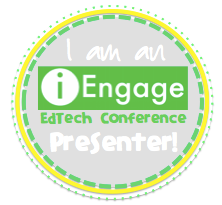Welcome back to the #D100bloggerPD book study on Donalyn Miller's Reading in the Wild: The Book Whisperer's Keys to Cultivating Lifelong Reading Habits! Thank you for joining us. Literacy Loving Gals is excited to host it's very first guest blogger. She brings to you some highlights of Chapter 2: Wild Readers Self-Select Reading Material.
Hello, my name is Courtney. I am a Literacy Coach and Reading Specialist in School District 100. I work alongside Colleen, who has welcomed me as a guest blogger, as well as Angela from Miss G Does 5th. I've been thinking about joining the blogging world and decided this would be the best way to get my feet wet. Thank you to Kristin from Reading and Owl of the Above for organizing this book study and inspiring me to start my first blog post!
Miller starts off Chapter 2 by telling us how she was struggling, alongside her husband, to purge the hundreds of books that have taken over their house throughout the years. These books were acquired by recommendations of trusted reading friends, book lists, review blogs and websites, book clubs and simply by (*gasp*) a cover! After many days of sorting, discussing and laughing, there ended up only being about 20 books worth passing along.
Hello, my name is Courtney. I am a Literacy Coach and Reading Specialist in School District 100. I work alongside Colleen, who has welcomed me as a guest blogger, as well as Angela from Miss G Does 5th. I've been thinking about joining the blogging world and decided this would be the best way to get my feet wet. Thank you to Kristin from Reading and Owl of the Above for organizing this book study and inspiring me to start my first blog post!
Miller starts off Chapter 2 by telling us how she was struggling, alongside her husband, to purge the hundreds of books that have taken over their house throughout the years. These books were acquired by recommendations of trusted reading friends, book lists, review blogs and websites, book clubs and simply by (*gasp*) a cover! After many days of sorting, discussing and laughing, there ended up only being about 20 books worth passing along.
After reading this, memories of me purging or keeping books flashed
through my mind and the feelings I had when doing it. As Wild Readers, we want
to hold onto our lifetime of reading experiences and gain new ones. Whether it
is reading a book review, taking a stroll through the bookstore, or having a
friend recommend a book, Wild Readers know how to search for and learn about
new books to help nurture our love of reading. It is our job to help students build
this confidence and competence in choosing their own books. This starts within
the classroom, allowing students to choose their own text, to foster engagement
and to increase reading motivation and interest. Miller claims teachers can support students by
providing book recommendations, increasing access to interesting,
engaging books and by promoting books during "reading conferences and personal
commercials".
Over the years, I have read a variety of
books aloud to my students. It wasn’t always easy to do, but for the most part,
it happened daily right before kids left my class. I taught grades K-8 and they
all loved it, especially the older ones! At times, I found myself wishing I was
able to keep a class just a tad bit longer because we were all on the edge of
our seats to find out the rest of the story. But there was always tomorrow and
the conversations that came along with it were priceless. Students made
connections to authors we’ve read, searched for sequels and books from the same
series or wanted to take the same book out to read again. They were so excited to be reading.
In case you haven’t been incorporating read-alouds into
your daily routines, or convinced you
should be, Miller points out some extra benefits:
- They build community.
- They expose children to books, authors, or genres they might not discover on their own.
- They provide prime opportunities to introduce students to genres they often avoid, like poetry, biographies and nonfiction.
- They support developing readers.
- They reinforce that reading in enjoyable.
Selecting Read Alouds
Teachers often come to me looking for ideas about what books to read-aloud. Consider Miller's suggestions to help you decide:
Teachers often come to me looking for ideas about what books to read-aloud. Consider Miller's suggestions to help you decide:
- Choose books from authors who will lead your students to more books. For example, look for well-known authors who appeal to students. The librarian is a great resource for this!
- Share a variety of texts, including nonfiction, poetry and online articles. Miller states children need more time to explore online reading material. Her students go to Wonderopolis, which offers videos, nonfiction text, discussion questions and vocabulary words relating to one engaging question every day. It's always important to explicitly model reading online!
- Consider time constraints and book length. Try to have a balance between longer and shorter texts.
- Decide how students will view illustrations. How will you show illustrations and text features? The document camera is a great way to show this to a room full of students. If you don't have access to one, allow students to view the book later.
- Read books that you enjoy. If you aren't excited about a book, your students won't be either.
- Ditch the read-aloud if it doesn't work. Sometimes good books don't make the best read-alouds. Talk with students about why you are moving on, offer the book as an independent choice and select a different one to read.
Reading Community Suggestions
Building a community of readers is pivotal. We have to show students how to love books starting with read-alouds. Miller shares some of her students’ favorite read-aloud activities:
Invite students to share their favorite read-alouds. In the beginning of the year, have each student bring in his or her favorite picture book or title. If students do not have the book, ask the librarian to check out the titles for you.
Speaking from experience as a substitute teacher, this makes total sense. I always felt so awkward reading the story that I had no idea about aloud to the class.
Building a community of readers is pivotal. We have to show students how to love books starting with read-alouds. Miller shares some of her students’ favorite read-aloud activities:
Invite students to share their favorite read-alouds. In the beginning of the year, have each student bring in his or her favorite picture book or title. If students do not have the book, ask the librarian to check out the titles for you.
When everyone has a book, students gather in groups and reread their beloved favorites with classmates. For students who lack meaningful early literacy experiences or don't read fluently, starting with easier books provides a community-building opportunity that levels the playing field.When you have a substitute teacher, leave a read-aloud different from the one you are already reading to the class.
Speaking from experience as a substitute teacher, this makes total sense. I always felt so awkward reading the story that I had no idea about aloud to the class.
Students express fierce ownership for the books you share together and don’t want someone unaware of the story to continue your read-aloud.
Participate in World Read Aloud Days.
It is always the first Wednesday in March, so I'm anticipating the students' excitement when I introduce it to them this year!
It is always the first Wednesday in March, so I'm anticipating the students' excitement when I introduce it to them this year!
World Read Aloud Day highlights the importance of literacy to all people and provides opportunities for children to reflect on their literacy and celebrate reading.
Invite students to select your next read-aloud.
Show students three to four brief book previews and let them vote. This always brings about excitement among the students.
Post a list of the texts you read.
Miller suggests teachers keep a running list of every poem, article, picture book, novel and informational text you read. I am going to implement this right away with the couple of 5th grade graders I see.
Show students three to four brief book previews and let them vote. This always brings about excitement among the students.
Post a list of the texts you read.
Miller suggests teachers keep a running list of every poem, article, picture book, novel and informational text you read. I am going to implement this right away with the couple of 5th grade graders I see.
Students will love watching the list grow throughout the year. It also serves as an anchor chart, reminding students how to accurately punctuate and capitalize titles.
Read-alouds provide students with support in choosing their
own books.
Bottom line, read-alouds are a powerful way to help students in their journey to becoming Wild Readers.
Bottom line, read-alouds are a powerful way to help students in their journey to becoming Wild Readers.
It helps to increase their title and author awareness, improving their background knowledge and experience, and foster increased motivation and engagement with reading through positive reading experiences.
Generate Further Interest
Read-alouds aren't the only way to initiate student interest in self-selecting books. Exposing students to different texts in a variety of ways can help. Miller offers some inventive ideas, such as:
Read-alouds aren't the only way to initiate student interest in self-selecting books. Exposing students to different texts in a variety of ways can help. Miller offers some inventive ideas, such as:
The Mature Shelf:
It is one shelf full of books kept behind her desk. These books are not recommended in the beginning of the year. Based on conversations during reading conferences, results from reading assessments and discussions with parents, books are then recommended to those students who are "emotionally and academically ready".
It is one shelf full of books kept behind her desk. These books are not recommended in the beginning of the year. Based on conversations during reading conferences, results from reading assessments and discussions with parents, books are then recommended to those students who are "emotionally and academically ready".
Selection Reflections:
Encourage students to reflect on their reading choices, starting by asking these five questions:
Encourage students to reflect on their reading choices, starting by asking these five questions:
- How do you find out about books that you would like to read?
- When you see a book or hear about it, how do you decide that it is a book you would or would not like to read?
- Do you ever abandon a book? Who or why not?
- Are you successful in choosing your own books to read? Why or why not?
Conferring Points:
Providing students with supported opportunities to preview, evaluate, and choose texts gives them the practice they need in self-selecting books.
Providing students with supported opportunities to preview, evaluate, and choose texts gives them the practice they need in self-selecting books.
Preview Stacks:
This is simply what it sounds like. A stack of books created by the teacher for a specific student(s). When making reading suggestions, Miller tells us to be careful not to influence students' opinions of books too much or take away their ability to choose freely what they want to read. When creating preview stacks, teachers have to make sure to strengthen and support students' self-selecting attempts while drawing on our own knowledge of their reading interests, abilities and needs. Questions to ask students: What genre do you want to read? What have you already looked at today? What was the last book you finished you really liked? What sort of book are you thinking about?
This is simply what it sounds like. A stack of books created by the teacher for a specific student(s). When making reading suggestions, Miller tells us to be careful not to influence students' opinions of books too much or take away their ability to choose freely what they want to read. When creating preview stacks, teachers have to make sure to strengthen and support students' self-selecting attempts while drawing on our own knowledge of their reading interests, abilities and needs. Questions to ask students: What genre do you want to read? What have you already looked at today? What was the last book you finished you really liked? What sort of book are you thinking about?
In reflection, this chapter came at a perfect time as our school just
wrapped up the Scholastic Book Fair. In the few moments I could steal during
the day to check it out, I usually ran into different classes of students
eagerly spending their money. Students were either excitedly showing off the
books they wanted or purchased or browsing the shelves, looking for the perfect
book. It got me thinking about student self selections because I noticed a few
of our struggling readers choosing books I knew, and I’m pretty sure they knew,
were too high for them. I tried to “re-direct” and offer suggestions within
their ability but, ultimately, it was up to the student. At that point, I
realized students had no idea how to
self-select appropriate materials. It's not that teachers aren't teaching students how to select books, because they are. I've witnessed lessons and conversations.
Perhaps we need to take a look at how we are helping to develop this ability and make the necessary changes to get students there faster. Wild Readers know they can find something to read anywhere. As teachers, it is our job to help foster this confidence among students to help them along their journey in becoming Wild Readers.
Thanks for reading my very first post as a guest blogger!
Courtney
Want to catch up on the #D100bloggerPD posts thus far? Click HERE to access the links and view the schedule for future posts. Next up in the book study is one of our multitalented middle school teachers, Rachel from Social Justice Heroes. Her post on Miller's vignette Curating a Classroom Library? goes live on Monday, November 23rd.
Perhaps we need to take a look at how we are helping to develop this ability and make the necessary changes to get students there faster. Wild Readers know they can find something to read anywhere. As teachers, it is our job to help foster this confidence among students to help them along their journey in becoming Wild Readers.
Thanks for reading my very first post as a guest blogger!
Courtney
Want to catch up on the #D100bloggerPD posts thus far? Click HERE to access the links and view the schedule for future posts. Next up in the book study is one of our multitalented middle school teachers, Rachel from Social Justice Heroes. Her post on Miller's vignette Curating a Classroom Library? goes live on Monday, November 23rd.








































Courtney,
ReplyDeleteI just love your post! Thank you so much for being a part of this blog book study- we are so lucky to have you in this study, in D100, and as part of the #D100bloggerPD crew! I must say- I have a weak spot for read alouds. I miss doing them dearly from when I was a classroom teacher and try and "guest read" in classrooms when I can! Two of my favorite class read alouds:
1: Witches by Roald Dahl. This is totally my mom's fault. I was a guest in her classroom once when I was little and she was reading this book to her students. The voices she made when reading are some that I can still hear to this day and the engagement on the student's faces is something I can't forget, either. And I was a child!
2. Skeleton Man by Joseph Bruchac. This is by far my most favorite book to read to students. It's a short chapter book and just flat out amazing. Every chapter ends with a cliffhanger and the pictures created in your mind from reading it are SO great. I seriously can't say enough about how awesome this read aloud is- and it also transitions into a nice mentor text for older kids. Plus there's a bonus- a sequel! Now, it's not as great as the first, but the kids ALWAYS fight over who gets to read it first- just because they were so captivated by the first book.
Thanks again for your post- I hope to see your very own blog soon!!
Love your comments, Kristin! ;)
DeleteThanks, Kristin! It's hard as a reading specialist to find time for a read-aloud. We have such a short time with the kids, I feel like they need to be reading in their own books with my support! Maybe we can make a goal for ourselves to start incorporating it once a week, starting with a short chapter book like Skeleton Man! I've never read it but am going to look into it for my 5th graders.
DeleteWe'll see about the blog :-) I need to finish getting used to Twitter first!
Courtney,
ReplyDeleteGreat post! Love your list of resources. Jim Trelease's The Read-Aloud Handbook is my most used and revered reference for sharing books with children. He introduces it with a poem by Strickland Gillilan "The Reading Mother" that reflects my childhood and supports my own personal practice:
You may have tangible wealth untold:
Caskets of jewels and coffers of gold.
Richer than I you can never be-
I had a mother who read to me.